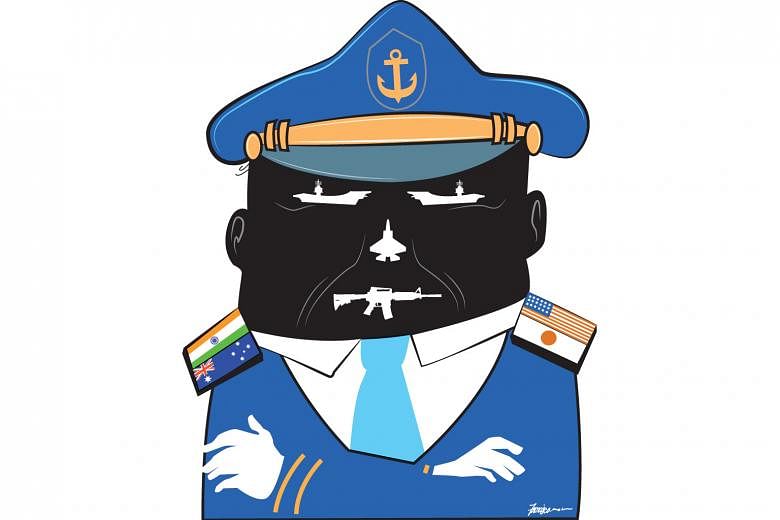Amid all the hectivities surrounding the Asean and East Asia summit meetings this week in Manila, another gathering in the Philippines capital that took place on the sidelines did not quite get the notice it probably deserves.
Two days before the Asean Summit, senior officials from the United States, Japan, Australia and India sat down for talks aimed at, in their words, keeping the Indo-Pacific region "free, open and inclusive". With this, the so-called Quad, short for Quadrilateral Dialogue, got a renewed lease of life. Should it gather momentum, Asia's security landscape could be altered for the next 100 years.
The first iteration of the Quad did not last long, perhaps because when it was mooted by Japanese Premier Shinzo Abe a decade ago during his all-too-brief first term, it was an idea whose time was yet to come. The uncharismatic Hu Jintao was still China's president and Beijing hadn't yet proclaimed its controversial nine-dash line claim over the South China Sea. India, always leery of needling China, particularly during the Manmohan Singh years, was a half-hearted participant.
Still, the first Quad meeting rattled China, which openly criticised the formation. In the event, the Quad was effectively killed in 2008 when then Australian Foreign Minister Stephen Smith, standing next to his Chinese counterpart Yang Jiechi, announced Canberra's withdrawal from the group.
A decade on, the Asia-Pacific strategic landscape has changed significantly. Beijing lost its fear of the US during the Barack Obama years when, eager to get China onside for his climate change deal, the 44th US President turned a blind eye to its increasingly assertive behaviour and island building in the South China Sea. The result has been that where it once chafed at excessive US surveillance in its backyard, China now confidently fixes its gaze a long way afield, asserting that the Pacific Ocean is "big enough for both China and the US" and setting up its first overseas military base in Djibouti, on the Horn of Africa.
Today, President Xi Jinping handles current US President Donald Trump with far more aplomb than does Mr Abe, a formal US ally. He can do so because China has secured its backyard, building where it wants in the South China Sea, installing radar and other military equipment, scaring off Vietnam from prospecting for oil within its exclusive economic zone and pressuring South Korea to bend to his will. Meanwhile, other long-time US allies in the region, such as the Philippines and Thailand, are redoing their sums.
China has also taken on the more powerful in Asia, intensifying its patrols in the waters around Japan, bothering Tokyo. On the other side of the map, with India, it has consistently shifted the goalposts in border negotiations and ignored New Delhi's sensitivities on the economic corridor it is building with Pakistan in disputed territory.
The two-month-long stand-off with India over the Doklam trijunction with Bhutan earlier this year, which came perilously close to open skirmishes between the two Asian giants, was a direct result of facts on the ground being sought to be altered to its advantage. Indeed, China is so used to having its way that the swift and forceful Indian response seemed to have taken it by surprise.
All this is causing concern not just in Asia but also around the world, including Washington and several European capitals. US assessment of Chinese behaviour was expressed unambiguously by Secretary of State Rex Tillerson in a major foreign policy speech last month when he plainly stated that "China's provocative actions in the South China Sea directly challenge international law and norms". Tellingly, Mr Tillerson went on to say that the US "will not shrink from China's challenges to the rules-based order".
The response to China's new strategic profile has been in the making for a while and its contours are now within view.
Fully aware that this juggernaut can be checked only by the US acting with two Asian nations - Japan and, to an extent, India - there have been attempts to fuse the two strategically. Mr Abe, his economy long ago pushed to second place by a surging China, and fearful of further marginalisation on the Asian landscape, has been a leading player, his political durability lending him added confidence as he goes about his mission.
While he has sought to make the constitutional changes at home that would allow Japan to have a regular military, fight overseas and come to the aid of an ally, he has assiduously sought to build a coalition of democracies with values that stand in open contrast to China's unilateralism, politically, economically and militarily. In all this, he has enthusiastically gone along with US attempts to bookend the Asia-Pacific with itself at one end and India, the dominant Indian Ocean power, at the other. Japan is now a firm participant in the annual Malabar exercises that the US conducts with India. This year, it sent the carrier Izumo to war games with Indian and US carriers in the Bay of Bengal.
This is where the Quad, which adds Australia, enters the frame. The US stoutly backs its presence, seeing Australia as a potentially significant naval power and a nation that has fought alongside it in every significant military campaign since the 1942 Battle of the Coral Sea. Mr Abe, too, enthusiastically endorses an Australian role. New Delhi, it seems, has shelved its reservations about Canberra. Hence, the Quad meeting in Manila.
Separately, the US Pacific Command has in recent years made dramatic semantic adjustments to the landscape in addition to the continuing military rebalance.
For the past four years, it has been referring to the "Indo-Asia-Pacific", a term it subsequently shortened to "Indo-Pacific". More recently, top US officials, including Mr Trump, have repeated that phrase ad nauseam, which is rather surprising given that this president is usually so allergic to the smallest holdover from the Obama days.
But the Indo-Pacific coinage, and the push to keep it "free and open" - the stated aim of the Quad - is part of the larger plan. The US is signalling to China that it is not the only game in Asia, only a part of it, no matter how powerful. At the same time, it is also an undisguised ploy to stoke Indian vanities and nudge New Delhi to shift away from its centrist instincts in foreign policy and towards a more committed relationship favouring the US and Japan.
This process has been going on for a bit. As its own fear of China grew, the US has been building up India as a counter within Asia, giving it access to ever more sophisticated defence technology, particularly in the sea control domain, and weaning it away from its traditional dependence on Russia for weapons.
India was the first military outside the US to get the P8i Poseidon maritime reconnaissance aircraft and recently agreed to buy Predator "Guardian" unmanned aerial vehicles, also for maritime use. A White House read-out of a meeting between Mr Trump and Indian Prime Minister Narendra Modi in Manila said they "pledged to enhance their cooperation as major defence partners, resolving that two of the world's great democracies should also have the world's greatest militaries".
To the credit of the Indians, whose moods tend to swing from excessive elation to dark despair, they have lately shown little thrill at being thus flattered. It is for this reason that unlike in 2005, when Indians thrilled at then US Secretary of State Condoleezza Rice saying the US would help India become "a major power in the 21st century", the reactions have been more muted, its steps carefully nuanced.
Indeed, a close reading of the statements put out by the four Quad nations after their first meeting shows that the Indians alone avoided mentioning issues like freedom of navigation and overflight, respect for international law, and the North Korean question - issues sensitive to China. Instead, they framed their participation as part of Mr Modi's Act East policy, "the cornerstone of engagement with the Asia-Pacific region".
And next month, India will host the foreign ministers of China and Russia for a trilateral meeting.
Still, there are indications that Mr Modi may be ready to put more muscle on the bones of that Act East policy.
One tiny indication is that he has accepted Singapore's invitation to participate in next year's Shangri-La Dialogue, the region's premier annual meeting of regional military and security chiefs, organised by the International Institute for Strategic Studies.
In recent years, India had chosen to keep a low profile at these meetings, not wishing to show its hand more than it needs to. Mr Modi's appearance, therefore, could electrify things.
Aside from Indian reluctance to call out China unless it is compelled to, factors other than the omission of a joint statement from Manila suggest that the Quad is unlikely to evolve too fast, or dramatically.
Economic ties with China have become so deep that the US, Japan and Australia cannot afford an adversarial relationship with it. Rather than get into a gang fight, therefore, what all Quad nations really expect of China is better behaviour and respect for each member's sensitivities.
South-east Asia, weary of China's relentless pressure, may take comfort in seeing the regional overlord corralled one way or the other. But a successful Quad would marginalise Asean and rather than its much cherished centrality, leave the grouping in the unwelcome position of being the stuffing in a less than wholesome sandwich.
Ultimately, how the Quad shapes will probably be determined not in Washington, Tokyo, Canberra and New Delhi but in Beijing. It is in China's interest, therefore, to moderate its own behaviour in a manner that reduces the impetus for an "Asian Nato" to rise around it.



